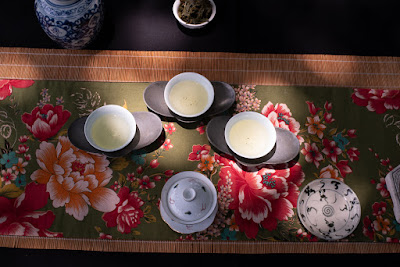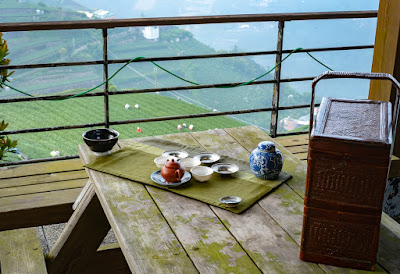A few days ago, I had tea at the Lin Gardens with a tea enthusiast who has purchased 6 aged '7542' puerh cakes from the late 1980s for roughly 70,000 USD! This high price reflects a new reality in the tea market: exclusive teas are getting more and more expensive. Affluent Chinese buyers bid up the prices of tea as they seek the same prestige and complex flavors of top quality wine.
If you've been following the wine market a little, you'll know that a bottle of top wine are reaching astronomical heights. The most expensive wines comes from Burgundy with its tiny estates: a bottle of Domaine Romanée Conti (6000 bottles per year) will easily take you back more than 10,000 USD. In 2001, I purchased 6 bottles of Chateau Margaux 1999, a premier grand cru classé from Bordeaux, at 120 USD per bottle and now each costs 600 USD! In the US, the current bottle, from 2014, of Opus One from Napa valley is priced at 385 USD... (Both wineries produce roughly 150,000 bottles per year of those wines). Tasting famous wines has become a very expensive luxury, while famous teas are still extremely affordable, especially if you follow my tips!
1. Great teas are like great wine: they are scarce, taste fantastic and are not meant to be drunk on a daily basis!
The most famous tea in China is the Da Hong Pao, a yan cha from Fujian province, comes from just 4 tea bushes on a rocky cliff in the Wuyi mountains! The Longjing plantation that was supplying emperor Qianlong (1711-1799) with green tea was slightly bigger with 18 trees! These 2 examples show that the scarcity of famous teas is actually even more acute than wine. Therefore, don't expect that you'll be able to purchase famous and exceptional teas on the cheap. In Taiwan, the best lot from the Dong Ding Oolong competition sells for
5000 USD for 300 grams (12 kg total production). And the
high mountain Oolong from FuShou shan, also dubbed the president's tea, retails at 155 USD for 150 gr on my online boutique. This plantation is one of the highest in Taiwan at 2500 meters elevation and is the unofficial supplier of the presidential palace in Taipei.
2. Group tastings are a good way to reduce the cost of expensive tea.
The wine world also uses this tool to let many drinkers share the cost of their education. We live in a world where ideas and general knowledge tends to become free thanks to the Internet. However, when it comes to wine or tea tasting, no words, pictures or videos can substitute for the actual tasting experience. The goal of this tea education is simple and essential: learning how great tea tastes helps you identify which teas are exceptionally delicious and which are not. It boils down to the same characteristics as great wines: an elegant and long lasting aftertaste. Great wines and teas have a presence that stays with you for several minutes. A few sips from a wine glass or from a tea cup are enough to make this experience. You don't need to drink the whole bottle or 8 brews of tea to experience the drink's quality. Actually, the law of diminishing marginal utility suggests that there's most pleasure in the first cup. Sharing great teas in a group is therefore an excellent strategy to lower their cost.

3. Purchase and brew top teas in tiny quantities.
This is where tea is different from wine, which is constrained by the format of the 750 ml bottle (or the half bottle). Loose tea can be sold and packaged in very small quantities, sometimes even down to the gram! This makes a lot of sense with top teas, because they are produced in very small amounts. Instead of selling it all to one very rich person, it's more satisfying to let a great number of people enjoy the tea, especially if they are going to share it in a group! This trend to smaller quantities is obvious in the puerh world. Pressed cakes are getting smaller and lighter as prices of leaves of old trees have skyrocketed in recent years.

Except for lowering the price of your purchase, there are another 3 reasons why it makes sense to brew top teas with fewer leaves. First, it's because this how you can best judge a tea. The standard brew at the Dong Ding Oolong competition, the biggest tea competition in the world, is 3 grams brewed for 6 minutes in a 120 ml porcelain standard cup. While average teas will not taste good under such conditions, the best Dong Ding Oolongs will still taste delicious, because the long brewing time emphasizes their amazing aftertaste. This doesn't mean that top teas should be brewed in this standardized manner. -Ideally, the brewing should be adapted to the character of each tea.- However, top teas shine most when pushed to their limits. The second reason for brewing top teas with fewer leaves than other teas is because the longer brews will compensate for the fact that you're using fewer leaves. Otherwise, with the same amount of leaves and longer brews you'd get a too strong concentration of flavors in your cup. Third, the most amazing tea miracle happens when you feel a lot of pleasure from a brew that seems light at first, but contains a lot of things that slowly unfold. Teaparker calls it the Wu Cha feeling, when the tea feels so pure that it doesn't feel like tea at first. Only an exceptional tea will taste satisfying and rich when brewed lightly. What is considered light will vary from one type of tea to another, of course. Loose green teas are meant to be brewed lighter than Oolongs.
During that afternoon at the Lin Gardens, I used only a handful of leaves from this
spring 2017 old arbor sheng puerh (2 or 3 grams) in a rather big Yixing teapot. My visitor was amazed by the fantastic taste and energy of the three long brews we made! The open leaves barely covered the bottom of the teapot.
Conclusion: The world of fine teas is getting more expensive and quality or pleasure isn't always guaranteed by a high price. This is another good reason to purchase expensive teas in small quantities.






























































